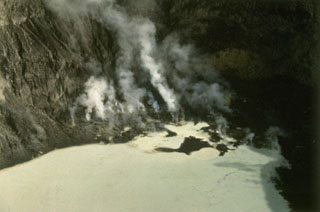Report on Mahawu (Indonesia) — November 1991
Bulletin of the Global Volcanism Network, vol. 16, no. 11 (November 1991)
Managing Editor: Lindsay McClelland.
Mahawu (Indonesia) Increased thermal activity
Please cite this report as:
Global Volcanism Program, 1991. Report on Mahawu (Indonesia) (McClelland, L., ed.). Bulletin of the Global Volcanism Network, 16:11. Smithsonian Institution. https://doi.org/10.5479/si.GVP.BGVN199111-266110
Mahawu
Indonesia
1.352°N, 124.865°E; summit elev. 1299 m
All times are local (unless otherwise noted)
Mahawu began to show signs of renewed activity in mid-Nov, about a month after the eruption of Lokon-Empung, 7 km WNW. Temperatures increased at the solfataras and fumaroles in and around the crater lake, and a vapor column rose 50-200 m above the crater. Although no magmatic eruption was observed, mud boiling from the base of the crater lake generated tremor with 1-2 mm amplitude. No volcanic tremor was detected. As of mid-Dec, degassing episodes were decreasing in number and intensity.
Geological Summary. The elongated Mahawu volcano immediately east of Lokon-Empung volcano is the northernmost of a series of young volcanoes along a SSW-NNE line near the margin of the Quaternary Tondano caldera. Mahawu is capped by a 180-m-wide, 140-m-deep crater that sometimes contains a small crater lake, and has two pyroclastic cones on its N flank. Historical activity has been restricted to occasional small explosive eruptions recorded since 1789. In 1994 fumaroles, mudpots, and small geysers were observed along the shores of a greenish-colored crater lake.
Information Contacts: VSI.

